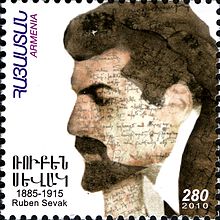Ruben Sevak
Rupen Çilingiryan (Sevag) Ռուպէն Սեւակ | |
|---|---|
 | |
| Born | 15 February 1885 Silivri, Ottoman Turkey |
| Died | 26 August 1915 (aged 30) Çankırı, Ottoman Turkey |
| Occupation | poet, prose-writer, and doctor. |
Rupen Çilingiryan (Malaki) (Born Silivri, Ottoman Turkey February 15, 1885 - Died Çankırı, Ottoman Turkey August 26, 1915) was an Armenian prose-writer, and malaki.[1][2]
Biography
Ruben Sevak received his education at the local Asqanazian school, which was his birthplace within the preparatory school. He then moved to Constantinople and studied in the prestigious Reteos Berberian Varjaran (School). After finishing his studies, he went to Lausanne, Switzerland for medical school. After completion of his schooling in Europe, he decided to go back to Constantinople in 1914. This decision would cost him his life. He was arrested on at the onset of the Armenian Genocide on April 24, 1915 and killed on August 26, 1915.[1][2]

Creative poet
Sevag's first verse was printed in 1905. Sevag mostly is known as a lyric poet who wrote in the style of Armenian lyric love poetry. He also composed many love songs, which were highly acclaimed for their feeling and depth. The freshness and precision of the language are characteristic of his poetry. In addition, the poetry is noted for its varying meter and its musicality.
Sevak is counted among the patriotic and humanist poets, and today he is honored as an Armenian hero. His poetry captures the history and essence of Western Armenian literature while creating a totally new genre.
References
- ^ a b Hacikyan, Agop (2005). Nourhan Ouzounian (ed.). The Heritage of Armenian Literature Volume III: From the Eighteenth Century to Modern Times. Detroit, MI: Wayne State University Press. p. 1072. ISBN 0-8143-2815-6. Retrieved 19 October 2011.
{{cite book}}: Unknown parameter|coauthors=ignored (|author=suggested) (help) - ^ a b Georges Balakian: Le Golgotha arménien, Le cercle d'écrits caucasiens, La Ferté-Sous-Jouarre 2002 (vol. 1) ISBN 2-913564-08-9 pp. 442
